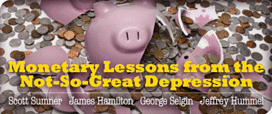I agree with Sumner that the Fed has the ability to create hyperinflation. The questions are how long it would take for this to happen and by which mechanism it would transpire. The mechanism I have in mind is a currency crisis in which everyone tries to get out of their dollar holdings. Saying that the Fed has the ability to create such a situation does not imply that it could achieve exactly four percent inflation, or even a number remotely close to that, for the coming quarter. These kinds of shifts are by their nature impossible to control with any precision. The Fed has the ability eventually to achieve significant inflation or significant deflation. That is very different from the ability to give us a particular desired number for the coming three months.
Sumner says he is not claiming that the Fed in September 2008 could have achieved five percent nominal GDP growth for 2008:Q4. May I ask why not, under his view of the world? In denying that the Fed has the ability to achieve an objective over the next three months, he seems to be implicitly endorsing the notion that there are lags in the effects of monetary policy. But if he agrees with me that it’s not feasible to do this within three months, how does he know we could do it within 12?
Or perhaps he is wishing to emphasize the difference between realizations and expectations — the Fed can’t actually deliver five percent nominal GDP growth, but it can nevertheless persuade the public this is what is going to happen? Then let me rephrase my position — there is nothing the Fed could have done in September 2008 that would have caused me to expect that the GDP growth rate in 2008:Q4 was going to be five percent. The reason that is my position is because I maintain that there is nothing the Fed could have done over the subsequent three months that would have achieved a five percent growth rate.
Given a longer time frame (and I think 12 months is still too short), I believe a target average for the nominal growth rate becomes more credible. But that’s because I believe in long and variable lags, with much that can happen that is beyond the Fed’s control that matters for output and prices. The Fed influences, but does not control, nominal GDP growth.
As for the mechanics of futures trading, my observation that with risk-neutral, equally informed traders there is an infinite demand for the contract at anything other than the equilibrium price has nothing to do with the specifics of how Sumner intends to implement this plan. It is a feature of any and all futures contracts. If I expect a growth rate of six percent and you offer me a contract at five percent, I make $1 expected profit if I buy $100 contracts, and I make $1 million expected profit if I buy $100 million contracts. If my goal is to maximize expected profit, I buy an infinite quantity of contracts. This is why I say that it is the equilibrium price of the contract, not the quantity of contracts written, that is the relevant aggregator of private beliefs. I do not think it is workable to implement a plan that is geared to the quantity of contracts written.

